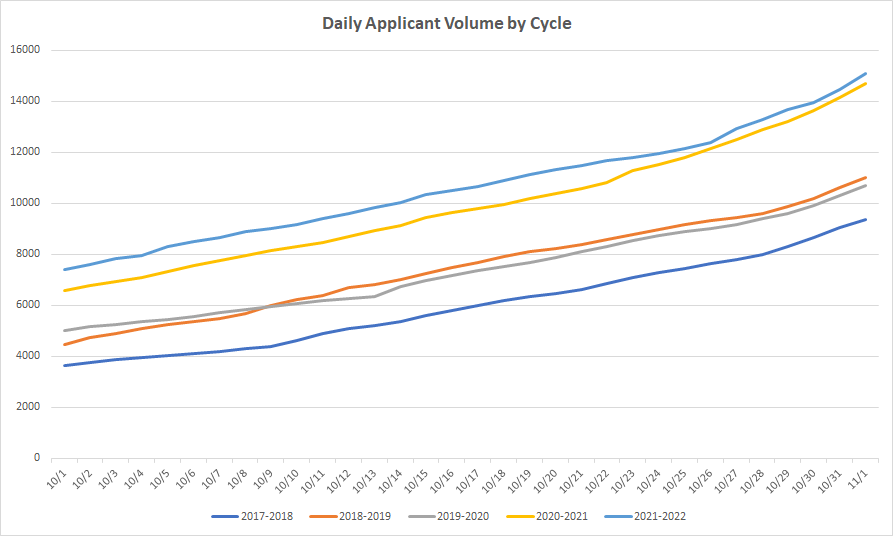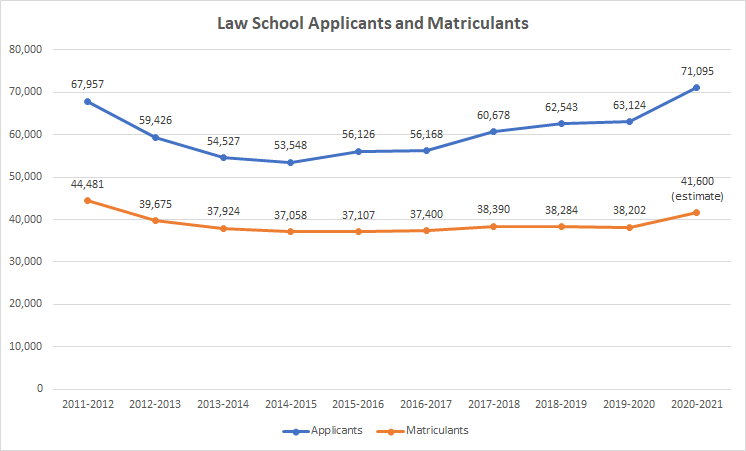We're not sure where the time has gone, but it's already November 1st, and we're a couple months into our 2021-2022 application cycle.
Obviously everyone is extremely interested in what applicant volume looks like. After last year, that's completely understandable. So let's take a look at where things are.
As of November 1st there has been a 2.5% increase in applicants to law school compared to the 2020-2021 cycle, and a 41.1% increase compared to 2019-2020.

There are 4.2% more applications than last year, meaning that the average applicant is applying to slightly more law schools than last year (i.e. more applications per applicant).
Now, it's still early. By November 1st in the 2020-2021 cycle we had 20.7% of our final applicant volume; in 2019-2020 we had 16.9%. So there's still quite a ways to go.
The majority of law schools are seeing an increase in the number of applications they've received.

Where the Cycle Stands Today
Most applicants are probably happy to hear that we've gone from a 12.5% increase in applicants as of October 1st to a 2.5% increase as of November 1st. The graph below might help show that trend of a narrowing gap.

This isn't just a result of a growing applicant pool making the percentage smaller — we've seen the gap decline from +831 applicants compared to last cycle as of October 1st to +374 as of November 1st.
Total numbers aren't the only factor in how competitive a cycle is; it also depends on how competitive the applicants themselves are (using LSAT score as a gauge of competitiveness).
Here is a breakdown of the change in LSAT applicant score by each score band:

As you can see, we have decreased applicant volume in the <140, 140-144, 165-169, 170-174, and 175+ score ranges.
On the top end, that's certainly a change from last cycle, when at this point we had over twice as many applicants in the 170+ score bands. And while it's true that we're pretty early in the cycle overall, we're not really that early for the highest scoring applicants anymore. In 2020-2021, by this point 40.7% of all 170+ scoring applicants in the cycle had submitted. That number was a bit lower in 2019-2020, at 35%, but it's still well ahead of where the applicant pool as a whole is. The highest scoring applicants apply much earlier than the rest of the pool. For applicants in that range, the fact that we're down at this point in the cycle is good news. The good news is relative though. Compared to 2019-2020, there are 85% more 170+ applicants. Last year was absolutely ridiculous in the high scoring bands, and so far this year is just a tad bit less so.
On the bottom end, it's very nice to see applicants in the lowest scoring ranges aren't just down, but continue to make up a smaller share of the applicant pool. This is probably the result of several factors. There are more free test-prep resources available than historically, with the most obvious difference being LSAC's LawHub. LSAC also introduced Score Preview in mid-2020, which allows first-time test takers to see their score before they choose whether to cancel. It seems plausible that this is resulting in more of the lowest scoring applicants choosing to cancel their score, resulting in fewer such scores to apply with.
What is interesting about this year so far is the middle ranges, those scoring between 150 and 164. Those applicants are up by 10.5% compared to last cycle, and are responsible for our present increase in applicants. That number has been declining over the long term, but it's interesting to wonder if those applicants are applying slightly earlier than they have historically (alternatively, it could be a consequence of the change in LSAT score distribution/averages compared to last year we discuss later).
The Cycle Moving Forward
Forward looking data gives reason for cautious optimism on the part of applicants.
Right now we are behind the number of first-time LSAT takers in the comparable period of the 2020-2021 cycle. From June through October 2020 there were 43,702 first-time LSAT takers. In that same period in 2021 there have been 40,297 first-time test takers, a 7.8% decrease. Interestingly, we're even more behind the 2019-2020 cycle in first-time test takers to date. The June-October period that year saw 44,654 first-time takers sit for the LSAT. Some people may remember that this was a source of confusion last cycle, since there were slightly fewer first-time LSAT takers but applicant volume was up by enormous amounts. This year we're seeing a somewhat similar phenomenon. There are fewer first-time test takers, but more people applying (though the increase in applicants is very small compared to last year).
LSAC has commented that they are seeing more applicants using a score received in the prior cycle to apply than is normal, which could help explain the increase in applicants on lower first-time taker volume. Something we've talked about before is whether April 2021 LSAT takers are a driving force behind that change. 10,932 people took the LSAT for the first time in April 2021. While it's technically counted as part of the 2020-2021 cycle, applicant volume after April scores were released shows that at least half of those individuals did not apply for fall 2021 admission. It's plausible that prospective 2021-2022 applicants, seeing how competitive the 2020-2021 cycle was, decided to take the LSAT well in advance of the cycle so that they could submit applications as early as possible.
Why is this good news for applicants looking forward? Well, we're at best flat in first-time LSAT takers compared to last year to date. We have the November 2021 administration coming up, which presently has 31,697 individuals registered. That number will drop as we approach test day. Even if we're conservative in our assumptions about how many registrants drop out, the numbers look good. A 12.5% dropout rate leaves us with 27,734 test takers — and if we assume that half are first timers (a higher rate than either 2019 or 2020) we're left with about 13,867 first-test takers for November. That still leaves us 2,000 first-time takers behind 2020-2021 from June through November, and just about flat with 2019-2020. Basically, there doesn't seem to be much fuel for an increase in applicants compared to last year, at least not from November's test.
The other good news is that LSAC has indicated recent LSAT scores are closer to normal levels than 2020-2021.

October 2021 scores averaged less than a point lower than October 2020 scores. Not a lot, but every bit helps bring us back to more normal scoring patterns (and hence applicant patterns). This suggests that the remaining 2021-2022 cycle tests are less likely to have scoring results that create a hyper-competitive applicant pool.
Of course, applicants are only one side of the cycle, the supply side. On the other side, law schools are the demand. It will be very interesting to watch the enrollment decisions schools make this cycle. With 137 schools reporting (preliminary) numbers, enrollment is up by 9%. This comes on the heels of several years of essentially unchanged enrollment. If current numbers hold, this is what it would look like:

Publicly, many schools that brought in larger classes have expressed that they have no regrets. That does fly in the face of some of the aggressive deferral-recruiting many schools engaged in. Those deferred students could fill up a decent part of the incoming 2022 class at some schools, decreasing available spots for new applicants. We don't have any information on deferral numbers — there's no way of knowing how much this is going to actually have an impact.
We're also aware of some schools that are specifically planning to bring in a smaller 2022 class to counterbalance their 2021 class. If a large number of schools choose to do that, it would likely decrease the available acceptances and increase competition.
Both the deferrals and reduced class size are likely to be a more school-specific challenge for applicants than a general cycle problem.
Conclusion
The good news is that this cycle doesn't seem likely to be more competitive than last year. It's still possible that we end with an increase in applicants, though that's becoming less likely.
Further, the top of the applicant pool is unlikely to be as strong (measured by LSAT score) as last year. It will be interesting to watch how schools respond to this, given widespread median increases among top schools. And as we discussed earlier, watch the middle LSAT ranges to see what happens with the present increase there.
Remember, we're still pretty early. The big things to keep an eye out for now are how applicant volume trends with October 2021 scores in, the final registrant volume for the November 2021 LSAT, and the preliminary registrant numbers for the January 2022 LSAT. Right now the trends this cycle have all favored applicants — and we check every day to see if that continues. As things change, we will post additional analysis.


.png)





